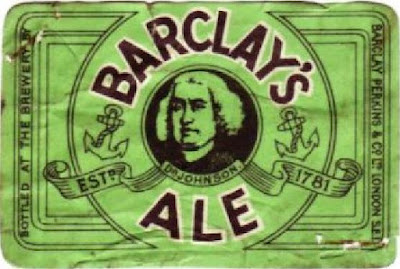What a difference a few years make. In 1886, Barclay’s X Ale was a simple affair, brewed from just pale and brown malt.
Now three new ingredients have been added and six points shaved off the gravity. On top of that, the boil time has been reduced by 30 minutes and the pitching temperature raised by 3º F. And here was me thinking that nothing ever changed very quickly in the 19th century. At least when no wars were raging.
New arrivals in the grist are crystal malt, flaked rice and some type of sugar. Not sure what it was. Probably some sort of invert. I’ve gone for No. 2, just to hedge my bets. No. 3 would leave it 22 SRM, No. 1 at 19 SRM. Take your pick. Whatever the choice, it comes out quite dark, about a typical colour for a modern Dark Mild.
To make way for the new ingredients, both the pale and brown malt percentages have been reduced.
The hopping rate is a little higher, despite the fall in gravity. Hops coming in the form of Mid-Kents from the 1888 and 1889 seasons, and American from 1889. The result is 62 IBU, way off the scale for a Mild today.
| 1890 Barclay Perkins X Ale | ||
| pale malt | 6.25 lb | 48.54% |
| brown malt | 3.50 lb | 27.18% |
| crystal malt | 0.125 lb | 0.97% |
| flaked rice | 1.50 lb | 11.65% |
| No. 2 invert sugar | 1.50 lb | 11.65% |
| Cluster 90 mins | 1.00 oz | |
| Fuggles 90 mins | 0.50 oz | |
| Fuggles 60 mins | 1.50 oz | |
| Fuggles 30 mins | 1.50 oz | |
| OG | 1058 | |
| FG | 1017 | |
| ABV | 5.42 | |
| Apparent attenuation | 70.69% | |
| IBU | 62 | |
| SRM | 20 | |
| Mash at | 154º F | |
| Sparge at | 165º F | |
| Boil time | 90 minutes | |
| pitching temp | 63º F | |
| Yeast | Wyeast 1099 Whitbread ale | |

So if you went into a Barclay Perkins pub in 1890 and you wanted a drink of this beer, what would you order?
ReplyDeletePint of Mild? Pint of Ale? Pint of X? Or just 'a pint please'?
Chris Pickles,
ReplyDeletein London, pint of Ale or just Ale.
That's a very small amount of crystal malt. Were they experimenting with it to see what effect it had before committing to more significant use?
ReplyDeleteInteresting recipe though. Will have to give it a spin.
Henry Stopes in his book "Malt and Malting" from 1885 claims that brown malt, due to the peculiar way it was produced, although being dark in itself, had a very poor colouring effect, sometimes even less than amber malt.
ReplyDeleteIt would be interesting to see a chart someday of the taps in a typical BP 1890s pub broken out by room and the names of the beers both what the brewer called them and what the customer did.
ReplyDeleteThis is the sort of malt bill I use at home to make my 21st century 'brown ale'. There's nothing new under the sun :-)
ReplyDeleteI am trying to figure out why they would use the rice. Rice seems to be swimming against the tide here. Wasn't rice more expensive than grain, pound for pound? Maybe they were experimenting? Homebrewing minds need to know.
ReplyDelete